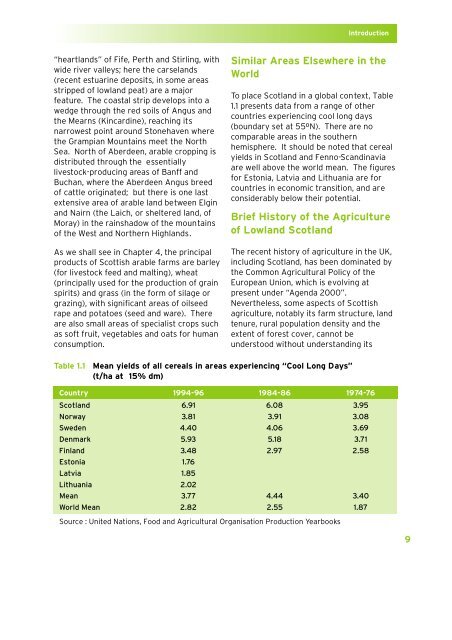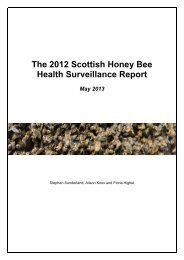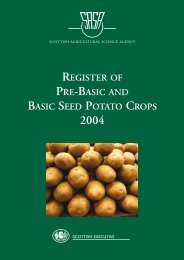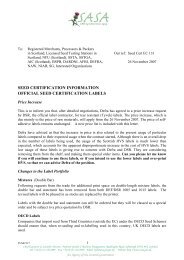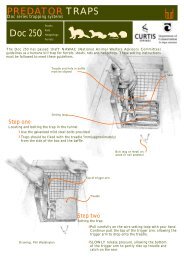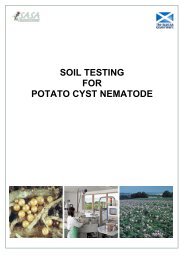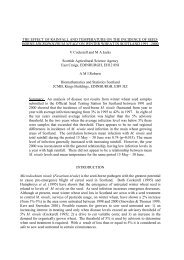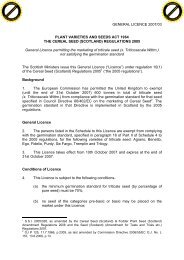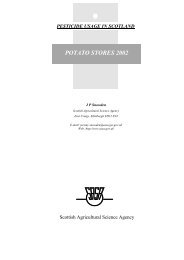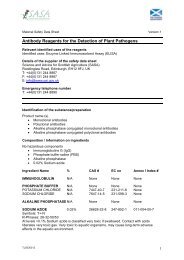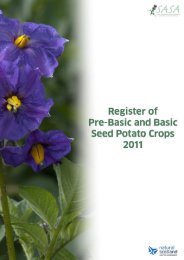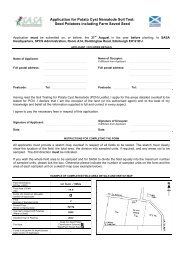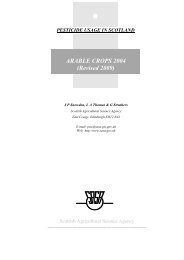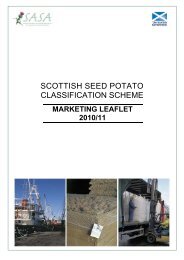Introduction“heartlands” <strong>of</strong> Fife, Perth and Stirl<strong>in</strong>g, withwide river valleys; here <strong>the</strong> carselands(recent estuar<strong>in</strong>e deposits, <strong>in</strong> some areasstripped <strong>of</strong> lowland peat) are a majorfeature. The coastal strip develops <strong>in</strong>to awedge through <strong>the</strong> red soils <strong>of</strong> Angus and<strong>the</strong> Mearns (K<strong>in</strong>card<strong>in</strong>e), reach<strong>in</strong>g itsnarrowest po<strong>in</strong>t around Stonehaven where<strong>the</strong> Grampian Mounta<strong>in</strong>s meet <strong>the</strong> NorthSea. North <strong>of</strong> Aberdeen, arable cropp<strong>in</strong>g isdistributed through <strong>the</strong> essentiallylivestock-produc<strong>in</strong>g areas <strong>of</strong> Banff andBuchan, where <strong>the</strong> Aberdeen Angus breed<strong>of</strong> cattle orig<strong>in</strong>ated; but <strong>the</strong>re is one lastextensive area <strong>of</strong> arable land between Elg<strong>in</strong>and Nairn (<strong>the</strong> Laich, or sheltered land, <strong>of</strong>Moray) <strong>in</strong> <strong>the</strong> ra<strong>in</strong>shadow <strong>of</strong> <strong>the</strong> mounta<strong>in</strong>s<strong>of</strong> <strong>the</strong> West and Nor<strong>the</strong>rn Highlands.As we shall see <strong>in</strong> Chapter 4, <strong>the</strong> pr<strong>in</strong>cipalproducts <strong>of</strong> Scottish arable farms are barley(for livestock feed and malt<strong>in</strong>g), wheat(pr<strong>in</strong>cipally used for <strong>the</strong> production <strong>of</strong> gra<strong>in</strong>spirits) and grass (<strong>in</strong> <strong>the</strong> form <strong>of</strong> silage orgraz<strong>in</strong>g), with significant areas <strong>of</strong> oilseedrape and potatoes (seed and ware). Thereare also small areas <strong>of</strong> specialist crops suchas s<strong>of</strong>t fruit, vegetables and oats for humanconsumption.Similar Areas Elsewhere <strong>in</strong> <strong>the</strong>WorldTo place <strong>Scotland</strong> <strong>in</strong> a global context, Table1.1 presents data from a range <strong>of</strong> o<strong>the</strong>rcountries experienc<strong>in</strong>g cool long days(boundary set at 55ºN). There are nocomparable areas <strong>in</strong> <strong>the</strong> sou<strong>the</strong>rnhemisphere. It should be noted that cerealyields <strong>in</strong> <strong>Scotland</strong> and Fenno-Scand<strong>in</strong>aviaare well above <strong>the</strong> world mean. The figuresfor Estonia, Latvia and Lithuania are forcountries <strong>in</strong> economic transition, and areconsiderably below <strong>the</strong>ir potential.Brief History <strong>of</strong> <strong>the</strong> Agriculture<strong>of</strong> Lowland <strong>Scotland</strong>The recent history <strong>of</strong> agriculture <strong>in</strong> <strong>the</strong> UK,<strong>in</strong>clud<strong>in</strong>g <strong>Scotland</strong>, has been dom<strong>in</strong>ated by<strong>the</strong> Common Agricultural Policy <strong>of</strong> <strong>the</strong>European Union, which is evolv<strong>in</strong>g atpresent under “Agenda 2000”.Never<strong>the</strong>less, some aspects <strong>of</strong> Scottishagriculture, notably its farm structure, landtenure, rural population density and <strong>the</strong>extent <strong>of</strong> forest cover, cannot beunderstood without understand<strong>in</strong>g itsTable 1.1Mean yields <strong>of</strong> all cereals <strong>in</strong> areas experienc<strong>in</strong>g “Cool Long Days”(t/ha at 15% dm)Country 1994-96 1984-86 1974-76<strong>Scotland</strong> 6.91 6.08 3.95Norway 3.81 3.91 3.08Sweden 4.40 4.06 3.69Denmark 5.93 5.18 3.71F<strong>in</strong>land 3.48 2.97 2.58Estonia 1.76Latvia 1.85Lithuania 2.02Mean 3.77 4.44 3.40World Mean 2.82 2.55 1.87Source : United Nations, Food and Agricultural Organisation <strong>Production</strong> Yearbooks9
<strong>Crop</strong> <strong>Production</strong> <strong>in</strong> <strong>the</strong> <strong>East</strong> <strong>of</strong> <strong>Scotland</strong>history. As this history is dist<strong>in</strong>ctlydifferent from that <strong>of</strong> o<strong>the</strong>r Europeancountries, a brief guide follows.Orig<strong>in</strong>s<strong>Scotland</strong> was entirely encased <strong>in</strong> ice up to20,000 years ago, and <strong>the</strong> land surface wasnot f<strong>in</strong>ally exposed for a fur<strong>the</strong>r 10,000years. Some important arable areas, forexample <strong>the</strong> Laich <strong>of</strong> Moray and <strong>the</strong>carselands <strong>of</strong> Perth and Stirl<strong>in</strong>g, did notfully emerge from <strong>the</strong> sea until around1,000 years ago, as a result <strong>of</strong> <strong>the</strong> slowrebound <strong>of</strong> surfaces depressed by hugeweights <strong>of</strong> ice. As no soils from previous<strong>in</strong>terglacial periods survive, virtually all <strong>of</strong><strong>the</strong> soils <strong>of</strong> <strong>Scotland</strong> date from around10,000 years ago (Chapter 3).As <strong>the</strong> climate improved, <strong>the</strong> advance <strong>of</strong>vegetation culm<strong>in</strong>ated <strong>in</strong> dense forest andscrub (vary<strong>in</strong>g proportions <strong>of</strong> birch, p<strong>in</strong>e,hazel and oak, depend<strong>in</strong>g on habitat, withalder and willows <strong>in</strong> wet areas). The earlyhunters would have had little impact on <strong>the</strong>environment but, by <strong>the</strong> start <strong>of</strong> <strong>the</strong>Second Millennium BC, a surpris<strong>in</strong>glysophisticated neolithic society (f<strong>in</strong>e goldjewellery, elaborate pottery and complexfunerary arrangements) had emerged <strong>in</strong> <strong>the</strong>lowlands <strong>of</strong> <strong>Scotland</strong>; <strong>the</strong>se people were atleast partly sedentary and partly dependentupon small-scale cropp<strong>in</strong>g <strong>of</strong> cereals andfibres, and livestock rear<strong>in</strong>g. They wereattracted by light, well-dra<strong>in</strong>ed soils,particularly <strong>in</strong> treeless areas such asOrkney but, on <strong>the</strong> ma<strong>in</strong>land, <strong>the</strong>y began<strong>the</strong> onerous work <strong>of</strong> fell<strong>in</strong>g <strong>the</strong> forest andclear<strong>in</strong>g stones and boulders. Laterneolithic/Bronze Age achievements, notablymegalithic build<strong>in</strong>g (e.g. Maes Howe) andcomplex stone circles (e.g. at Callanish),show that <strong>the</strong>re was a cont<strong>in</strong>u<strong>in</strong>g surplus <strong>of</strong>food beyond subsistence needs.Up to <strong>the</strong> medieval period, <strong>the</strong> rate <strong>of</strong>progress <strong>in</strong> clear<strong>in</strong>g <strong>the</strong> forest andcultivat<strong>in</strong>g <strong>the</strong> soil <strong>of</strong> <strong>the</strong> lowlandsdepended upon a variety <strong>of</strong> factors (e.g.slowed by cooler, wetter conditions around1,000BC; accelerated by <strong>the</strong> advent <strong>of</strong> irontools around 500BC; <strong>in</strong>terrupted by periods<strong>of</strong> warfare). By 1200AD, it is likely thatmost <strong>of</strong> <strong>the</strong> potentially-productive lowlands<strong>of</strong> <strong>the</strong> <strong>East</strong> <strong>of</strong> <strong>Scotland</strong> had been cleared <strong>of</strong>forest. The uplands also began to lose <strong>the</strong>irforest cover at that time ow<strong>in</strong>g to <strong>the</strong><strong>in</strong>tensive sheep rear<strong>in</strong>g <strong>in</strong>troduced by <strong>the</strong>monasteries; graz<strong>in</strong>g pressure and timberexploitation over <strong>the</strong> follow<strong>in</strong>g 500 yearsensured that virtually all <strong>of</strong> <strong>the</strong> nativewoodland <strong>in</strong> <strong>the</strong> study area disappeared.The areas <strong>of</strong> arable agriculture (more<strong>in</strong>tensively-cultivated <strong>in</strong>field, and outfield,with complex subdivisions to ensure fairdistribution <strong>of</strong> land among tenants),devoted to <strong>the</strong> production <strong>of</strong> barley andoats for direct human consumption, wereislands <strong>of</strong> cultivation <strong>in</strong> a wider sea <strong>of</strong>common land, which was exploited forgraz<strong>in</strong>g, fuel (wood and peat) and build<strong>in</strong>gmaterials (stone and turf). The fraction <strong>of</strong><strong>the</strong> land area that was cultivated fluctuatedaccord<strong>in</strong>g to population and climaticchanges, but, at least from <strong>the</strong> seventeenthcentury onwards, an <strong>in</strong>creas<strong>in</strong>g proportion<strong>of</strong> <strong>the</strong> uncultivated land came <strong>in</strong>tocultivation.The Basis <strong>of</strong> Land TenureFrom around 1150, <strong>the</strong> rulers <strong>of</strong> <strong>Scotland</strong><strong>in</strong>troduced a feudal system <strong>of</strong> land tenureto <strong>the</strong> lowlands <strong>of</strong> <strong>Scotland</strong>, although moredist<strong>in</strong>ctly Celtic or Nordic arrangements didsurvive much longer <strong>in</strong> <strong>the</strong> West and North.In <strong>the</strong> <strong>East</strong> <strong>of</strong> <strong>Scotland</strong>, as def<strong>in</strong>ed here, <strong>the</strong>changes were complete by 1250, after <strong>the</strong>military subjugation <strong>of</strong> <strong>the</strong> last Celtic rulers<strong>of</strong> Moray. Although formally styled K<strong>in</strong>g orQueen <strong>of</strong> Scots, <strong>the</strong> medieval rulers <strong>of</strong><strong>Scotland</strong> considered <strong>the</strong>mselves to beoutright owners <strong>of</strong> all <strong>of</strong> its land. Theconcept <strong>of</strong> feudal tenure was imposed onEngland by <strong>the</strong> <strong>in</strong>vad<strong>in</strong>g Normans (i.e. from10


